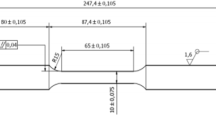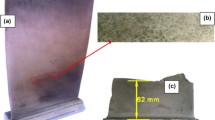Abstract
Since compressors have components rotating at high speed, the most common cause of failure in compressors is their high cycle fatigue. In the present study, one of the rotating blades on the first row of an axial flow compressor was prematurely fractured. The crack position and direction were determined, using nondestructive tests. The results indicated that fatigue cracking initiated at two corrosion pits on the surface of the pressure side of the blade in response to corrosive compounds in the site atmosphere. The total life of the blade, from corrosion pit initiation to unstable fatigue crack growth, was calculated. The blade life had three stages: pit initiation and pit growth, pit transition to initial crack and stable crack growth reaching a critical value where the final fracture occurred. Pit growth and its transition to initial cracking were described. The time an equivalent pit requires to reach initial fatigue cracking was subsequently calculated. The number of cycles was calculated via two methods until initial cracking reached unstable growth. The first calculation was performed, using ZENCRACK fracture mechanics code. These results demonstrated that the rate of fatigue crack growth was at first slow and stable. After a period of time, the stress intensity factor reached a critical value where the crack began to propagate unstably. A MATLAB code was written based on Paris model as the second method for estimating fatigue life. The results obtained from drawing a comparison between these methods revealed that ZENCRACK crack shape simulation was in agreement with the fatigue beach marks.














Similar content being viewed by others
References
A. Rama Rao, B.K. Dutta, Vibration analysis for detecting failure of compressor blade. Eng. Fail. Anal. 25, 211–218 (2012)
J. Tian, X. Liu, S. Chen, Fracture analysis on compressor blades. Int. J. Fatigue 13(4), 333–336 (1991)
N.S. Xi, P.D. Zhong, H.Q. Huang, H. Yan, C.H. Tao, Failure investigation of blade and disk in first stage compressor. Eng. Fail. Anal. 7(6), 385–392 (2000)
E. Poursaeidi, A. Babaei, M.R. Mohammadi Arhani, M. Arablu, Effects of natural frequencies on the failure of R1 compressor blades. Eng. Fail. Anal. 25, 304–315 (2012)
E. Poursaeidi, A. Babaei, F. Behrouzshad, M.R. Mohammadi Arhani, Failure analysis of an axial compressor first row rotating blades. Eng. Fail. Anal. 28, 25–33 (2013)
R. Derakhshandeh-Haghighi, Metallurgical analysis and simulation of a service-fractured compressor blade made of ASTM S45000 alloy. J. Fail. Anal. Prev. 17(3), 522–528 (2017)
A. Kermanpur, H. Sepehri Amin, S. Ziaei-Rad, N. Nourbakhshnia, M. Mosaddeghfar, Failure analysis of Ti6Al4 V gas turbine compressor blades. Eng. Fail. Anal. 15(8), 1052–1064 (2008)
V. Infante, J.M. Silva, M. de Freitas, L. Reis, Failures analysis of compressor blades of aeroengines due to service. Eng. Fail. Anal. 16(4), 1118–1125 (2009)
L. Witek, Crack propagation analysis of mechanically damaged compressor blades subjected to high cycle fatigue. Eng. Fail. Anal. 18(4), 1223–1232 (2011)
E. Poursaeidi, H. Bakhtiari, Fatigue crack growth simulation in a first stage of compressor blade. Eng. Fail. Anal. 45, 314–325 (2014)
E. Poursaeidi, M. Sanaieei, H. Bakhtyari, Life estimate of a compressor blade through fractography. Int. J. Eng. Trans. A Basics 26(4), 393 (2012)
E. Silveira, G. Atxaga, A.M. Irisarri, Failure analysis of a set of compressor blades. Eng. Fail. Anal. 15(6), 666–674 (2008)
E. Poursaeidi, O. Pedram, An outrun competition of corrosion fatigue and stress corrosion cracking on crack initiation in a compressor blade. Int. J. Eng. Trans. B Appl. 27(5), 785 (2013)
M.R. Jahangiri, A.A. Fallah, A. Ghiasipour, Cement kiln dust induced corrosion fatigue damage of gas turbine compressor blades—a failure analysis. Mater. Des. 62, 288–295 (2014)
M. Cerit, K. Genel, S. Eksi, Numerical investigation on stress concentration of corrosion pit. Eng. Fail. Anal. 16(7), 2467–2472 (2009)
N.J. Lourenço, M.L.A. Graça, L.A.L. Franco, O.M.M. Silva, Fatigue failure of a compressor blade. Eng. Fail. Anal. 15(8), 1150–1154 (2008)
L. Hagn, Lifetime prediction for parts in corrosive environments, in Corrosion in Power Generating Equipment (1983), pp. 481–516
D. Colombo, M. Giglio, A methodology for automatic crack propagation modelling in planar and shell FE models. Eng. Fract. Mech. 73(4), 490–504 (2006)
M.R. Alam, K. Munaswamy, A.S.J. Swamidas, Experimental and numerical studies on dynamic crack growth in layered slate rock under wedge impact loads: part II–non-plane strain problem. Fatigue Fract. Eng. Mater. Struct. 30(10), 915–931 (2007)
M. Schöllmann, M. Fulland, H.A. Richard, Development of a new software for adaptive crack growth simulations in 3D structures. Eng. Fract. Mech. 70(2), 249–268 (2003)
FRANC3D, Concepts and Users Guide. V1. 14 (Cornell University, Ithaca, 1999)
M. Schöllmann, H.A. Richard, FRANC/FAM—a software system for the prediction of crack propagation. J Struct Engng 26(1), 39–48 (1999)
D. Bremberg, G. Dhondt, Automatic crack-insertion for arbitrary crack growth. Eng. Fract. Mech. 75(3), 404–416 (2008)
Zencrack User’s Manual. V7.5. Zentech International Limited, 2007
R. Branco, F.V. Antunes, J.D. Costa, Lynx: A user-friendly computer application for simulating fatigue growth of planar cracks using FEM. Comput. Appl. Eng. Educ. 22(3), 529–540 (2014)
E. Poursaeidi, A. Kavandi, K. Vaezi, M.R. Kalbasi, M.R. Mohammadi, Arhani, Fatigue crack growth prediction in a gas turbine casing. Eng. Fail. Anal. 44, 371–381 (2014)
A.R. Maligno, S. Rajaratnam, S.B. Leen, E.J. Williams, A three-dimensional (3D) numerical study of fatigue crack growth using remeshing techniques. Eng. Fract. Mech. 77(1), 94–111 (2010)
M. Salari, A.R. Shahani, Kashani H. Moayeri, Fatigue crack growth analysis of a reinforced cylindrical shell under random loading. Fatigue Fract. Eng. Mater. Struct. 37, 1197–1210 (2014)
P.A. Schweitzer, Metallic Materials: Physical, Mechanical, and Corrosion Properties. V19 (CRC Press, Boca Raton, 2003)
A.C. Reardon (ed.), Metallurgy for the Non-Metallurgist (Almere, ASM International, 2011)
G. Stephani, Overview of stress corrosion cracking in stainless steel: electronic enclosures in extreme environmental conditions. DfR Solutions. www.dfrsolutions.com
W. Dietzel, Fracture mechanics approach to stress corrosion cracking, in Anales de Mecánica de la Fractura, vol. 18 (2001), pp. 1–7
C.S. Alloys, Alloys for Corrosive Environments. CRS Holdings Inc., vol. U.S.A. 7 03/2.5M, (2003)
R. Cottis, Guides to Good Practice in Corrosion Control Stress Corrosion Cracking (National Physical Laboratory, Teddington, 2000)
D. Linden, in Long Term Operating Experience with Corrosion Control in Industrial Axial Flow Compressors. Proceedings of the Fortieth Turbomachinery Symposium 2011, Houston, Texas
NASA Johnson Space Center, Southwest Research Institute, NASGRO Reference Manual V4.02. In: SwRI, editor (2002). p. 138
T.C. Lindley, P. McIntyre, P.J. Trant, Fatigue-crack initiation at corrosion pits. Met. Technol. 9(1), 135–142 (1982)
A. Midha, D.E. Wert, Martensitic age-hardenable stainless steel. Adv. Mater. Process. 169(9), 30–33 (2011)
D. Broek, Elementary engineering fracture mechanics, 4th edn. (Martinus Nijhoff, Leiden, 1984)
Author information
Authors and Affiliations
Corresponding author
Rights and permissions
About this article
Cite this article
Pedram, O., Poursaeidi, E. Total Life Estimation of a Compressor Blade with Corrosion Pitting, SCC and Fatigue Cracking. J Fail. Anal. and Preven. 18, 423–434 (2018). https://doi.org/10.1007/s11668-018-0417-5
Received:
Revised:
Published:
Issue Date:
DOI: https://doi.org/10.1007/s11668-018-0417-5




